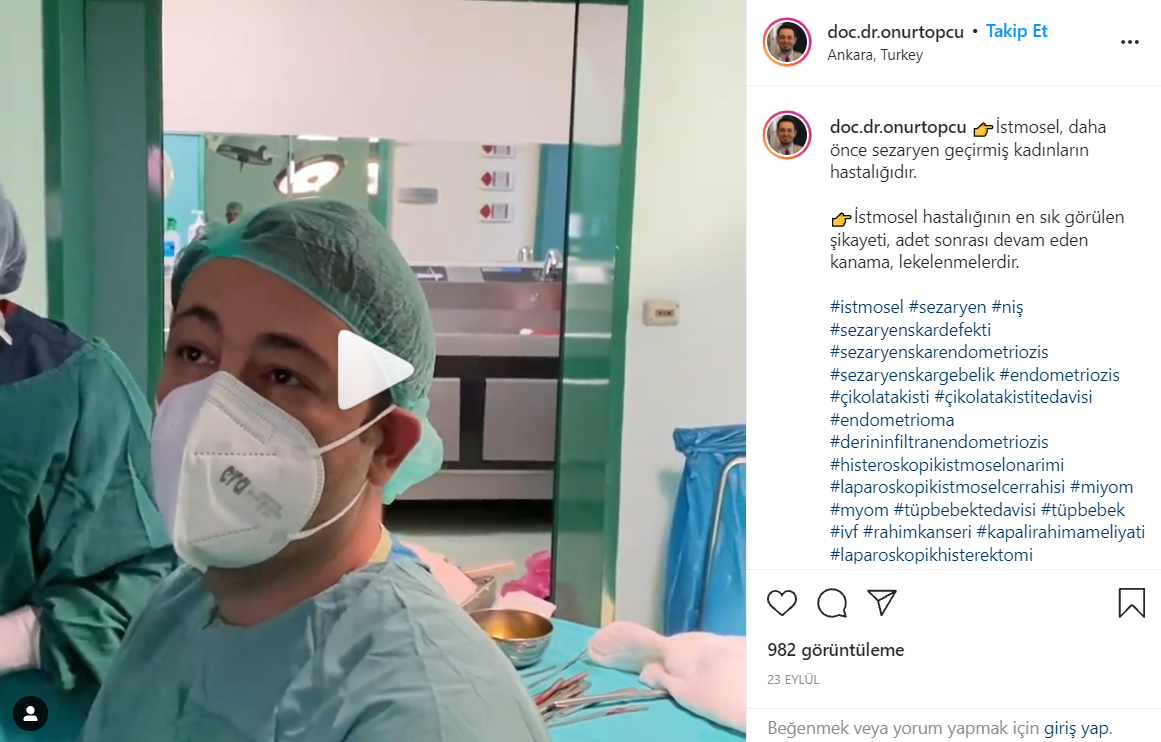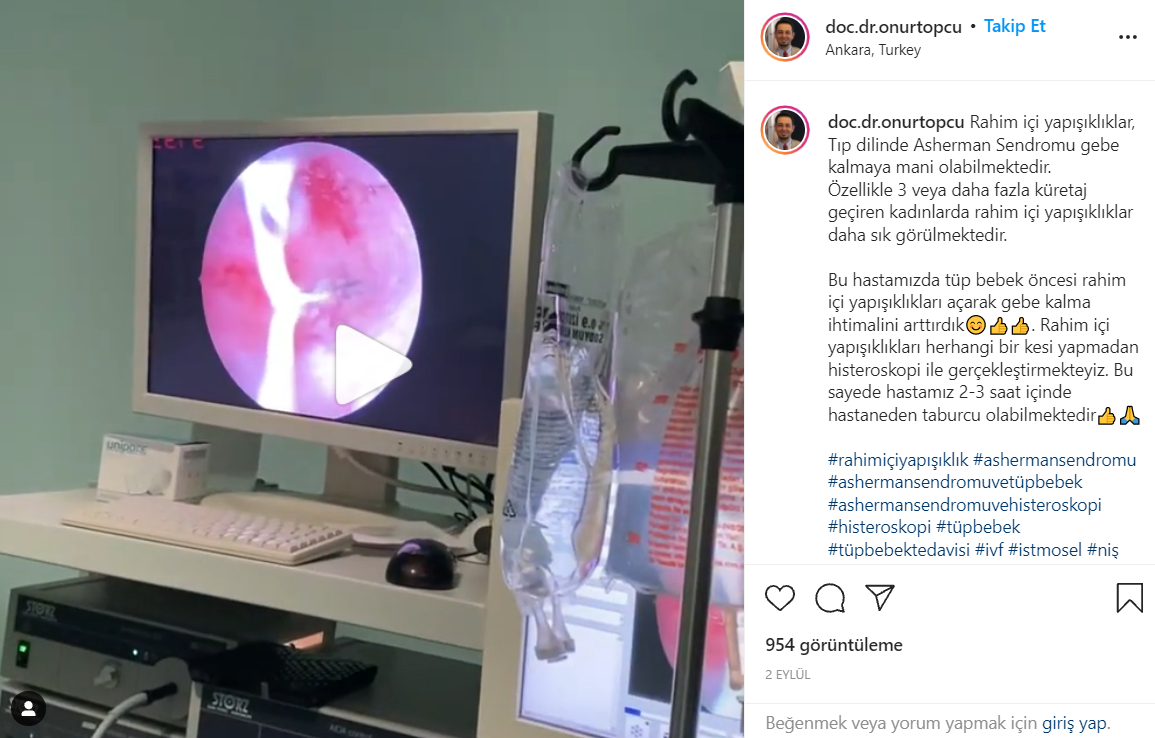
Prof. Dr. Onur Topçu
Gynecology and Obstetrics Specialist
The information provided below about medical diseases is not for advertising purposes. These are articles intended to inform and promote patients. If you think you have one of the diseases listed below, we recommend that you be examined by healthcare professionals who specialize in this field for medical advice and treatment.
Hysteroscopy Procedure
As a physician who has performed thousands of hysteroscopy procedures in the hospitals where I work, I can easily say that hysteroscopy is a patient-friendly procedure. In order to ensure that a patient-friendly surgical procedure such as hysteroscopy can be performed widely throughout Turkey, I have served and continue to serve as a trainer in the training of Gynecology and Obstetrics Assistants and Specialists at both Gynecology and Obstetrics Congresses and Local Meetings.I am still actively working to ensure that this patient-friendly surgical procedure becomes widespread. Some of the special hysteroscopy procedures I perform are istmocele defect repair, septum (uterine curtain correction) resection, Asherman syndrome (intrauterine adhesion removal). You can watch procedures such as correction of intrauterine polyps and intrauterine myoma resections both on my Youtube channel and on my Instagram page, and you can watch my informative articles. you can read.
After working in Education-Research and Private hospitals for years, I have been seeing my patients in my own clinic since November 2020. I see my patients in our clinic and perform the necessary surgical operations in private hospitals with which I have agreements.
Diagnostic hysteroscopy is required in many patients who will undergo in vitro fertilization treatment. I perform diagnostic hysteroscopy in my clinic at an affordable fee. For your appointments, you can call us at 0533 049 66 87.
You can contact us via WhatsApp by clicking here to make your appointment.
A photo from the hysteroscopy training courses we organized.
Origin of the Term Hysteroscopy
Hysteroscopy; It is a combination of the words hystero and scopi. Hystero means uterus and scopy is used in the sense of seeing and observation. In other words, hysteroscopy is the imaging of the inside of the uterus. Hysteroscopy is an important diagnostic and treatment method. Because the physician performing the procedure sees the inside of the uterus (womb) clearly during the hysteroscopy procedure and can immediately diagnose and treat any disease in the uterus.
The most important advantage of the hysteroscopy procedure is that after this procedure, the patient can be discharged from the hospital on the same day and return to his daily life and activities. Performing this procedure in experienced hands is advantageous for the patient, because the physician has to treat the patient within a certain period of time due to the fluids used in the hysteroscopy procedure, which provide clear visualization of the inside of the uterus. I have been helpful to thousands of patients by performing thousands of hysteroscopy procedures over the years and I continue to be helpful. In the rest of my article, I will try to share useful information about the situations in which I apply this procedure and which patients can benefit from this method.
What are the Situations That Require Hysteroscopy?
Hysteroscopy is a procedure used to diagnose and treat gynecological diseases, especially gynecological diseases that concern the inner part of the uterus.It is used to make a definitive diagnosis in the cases I mentioned below
- In the diagnosis of polyps occurring in the uterus
- In the diagnosis of myomas formed in the uterus
- In determining the causes of recurrent miscarriage
- In the investigation of the cause of infertility
- To find out the cause of heavy menstrual bleeding or menstrual irregularities
- Finding the source of post-menopausal bleeding
- In the investigation of intrauterine wall thickness
- In the diagnosis of isthmocele
- In determining possible causes of infertility
- It is used to diagnose uterine cancer (endometrium cancer).
It is used for treatment in the following situations:
- In the treatment of polyps and fibroids originating from the uterus
- Removal of contraceptive devices such as spirals inside the uterus
- Taking a biopsy from the endometrium (inner lining of the uterus) in cases of bleeding
- To take a biopsy from the endometrium (inner lining of the uterus) in the thickness of the uterine wall. To cut or open the adhesions in the uterus
- To correct isthmocele defect
- It is used in the treatment of uterine cancer in selected patients.
Application Technique of Hysteroscopy
A detailed evaluation of the inside of the uterus is performed by entering the uterus through the cervix with a hysteroscopy instrument with an outer diameter of 4 to 10 millimeters. No incision is made in the abdomen. The hysteroscopy device has a fixed light source and pathways that allow serum passage to ensure stable image quality of the inside of the uterus. Apart from this, the surgical instruments to be used with the hysteroscope vary depending on the hysteroscopy instrument and the surgical procedure to be performed.
What are the Hysteroscopic Applications?
Hysteroscopic applications; It is divided into two: diagnostic (office) hysteroscopy and surgical (operative hysteroscopy).
Diagnostic (Office) Hysteroscopy
Diagnostic hysteroscopy, which is frequently performed today; It is of great importance for the diagnosis and treatment of gynecological diseases. In the diagnostic (office) hysteroscopy procedure, where adhesions, myomas and polyps can be detected and which is often required before in vitro fertilization treatment; All problems in the uterus can be easily seen. All intrauterine lesions suspected by ultrasonography are easily seen during hysteroscopy and the diagnosis is easily made. It provides great benefit to women in terms of planning the next treatment phase. Another name for this procedure is office hysteroscopy. In other words, this procedure can be performed in office conditions without requiring general anesthesia. I also easily apply this process in my own practice (office).
These treatment plans are very diverse. While a polyp or myoma originating from the uterus can cause excessive bleeding in women, these lesions can also cause infertility and pain in women. Adhesions formed in the uterus or defects in the uterus due to cesarean section, such as isthmocele, can be easily seen with hysteroscopy and allow planning for treatment. The most important advantage of diagnostic hysteroscopy is that it can be performed in office conditions and general anesthesia is not required.
Surgical (Operative) Hysteroscopy
It can be preferred as a surgical method for the definitive treatment of all problems occurring in the uterus. Operative (surgical) hysteroscopy is performed to cut the intrauterine curtains that cause recurrent miscarriages, that is, septum resection, to correct the isthmocele sac, to treat polyps and myomas formed in the inner tissue of the uterus, for biopsy purposes in patients with increased endometrial thickness, and to open intrauterine adhesions that cause infertility.Operative hysteroscopy is performed under general anesthesia or spinal anesthesia. The cervix is dilated to approximately 7 or 10 mm and the patient is treated. After the procedure, the patient is discharged on the same day and allowed to return to daily activities. Sexual intercourse is prohibited for a maximum of 1 week.
How is Hysteroscopy Done?
The hysteroscopy process begins with the cleaning of the vaginal area and the passage of the hysteroscopy instrument through the cervix. Meanwhile, some serum solutions are used to inflate the uterus to facilitate the surgical procedure. Therefore, it is normal to have a small amount of watery discharge from the vagina after the procedure. This current ends within a day. In diagnostic (office) hysteroscopy, a hysteroscopy with a thickness of 3 to 5 millimeters is entered through the cervix and the inside of the uterus is visualized. Thus, more accurate diagnosis and treatments become possible. Diagnostic hysteroscopy generally does not require anesthesia and the procedure is performed with local anesthesia. There is no need to stay in the hospital after this hysteroscopy procedure, in which there is no pain and only the uterus is examined.
Post-Hysteroscopy Process
- After operative hysteroscopy, mild pain that is similar to menstrual pain and lasts for a day or two is normal.
- The level of pain that requires painkillers may vary from person to person. If your pain continues after the procedure, there is no harm in using the painkiller prescribed by the doctor.
- After hysteroscopy, sexual intercourse may be prohibited for a certain period of time. You can return to your active sexual life immediately after the recovery period. This period is one week at most.
- After the procedures performed with surgical hysteroscopy, your doctor may start hormonal treatments if necessary.
I try to heal our patients who need hysteroscopy with years of experience by performing diagnostic hysteroscopy under office conditions and operative (surgical) hysteroscopy under operating room conditions. You can call or visit our clinic to get more information about the hysteroscopy procedure.
Stay healthy..
Assoc. Dr. H. Onur Topçu
Gynecology & Birth-In Vitro Fertilization and Advanced Gynecological Endoscopy Specialist
Prof. Dr. H. Onur Topçu
Kadın Hastalıkları & Doğum-Tüp Bebek ve İleri Derece Jinekolojik Endoskopi Uzmanı
PATIENT COMMENTS
Onur hoca sürecin en başından ameliyat sonrasına kadar her aşamada çok destekçi ve cesaretlendirici oldu. Sürecin tüm detaylarını eksiksiz ve net bir şekilde anlatarak bizi en iyi ve doğru şekilde bilgilendirdi. Onur hocama çok teşekkür ediyor ve kesinlikle bu alanda bir doktor arayışında olanlara t avsiye ediyorum.
Arz*** A***





